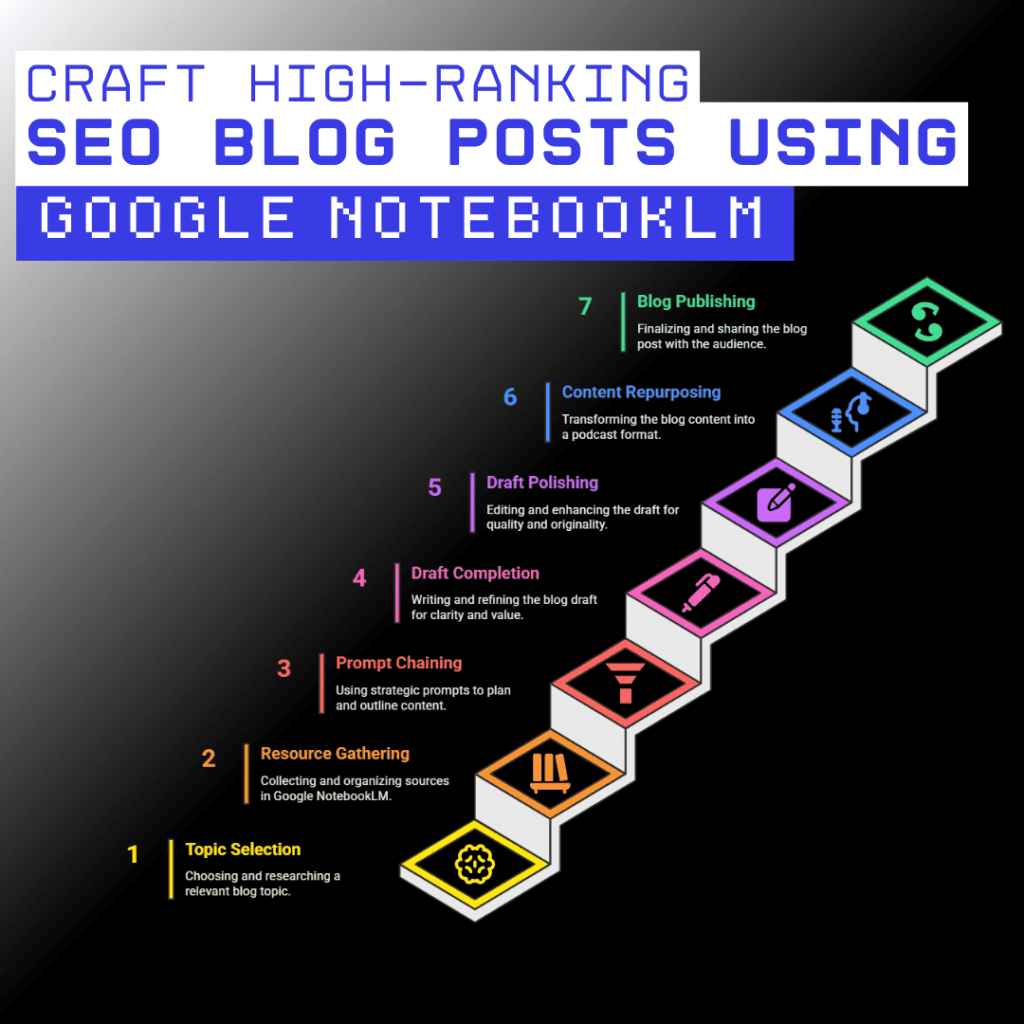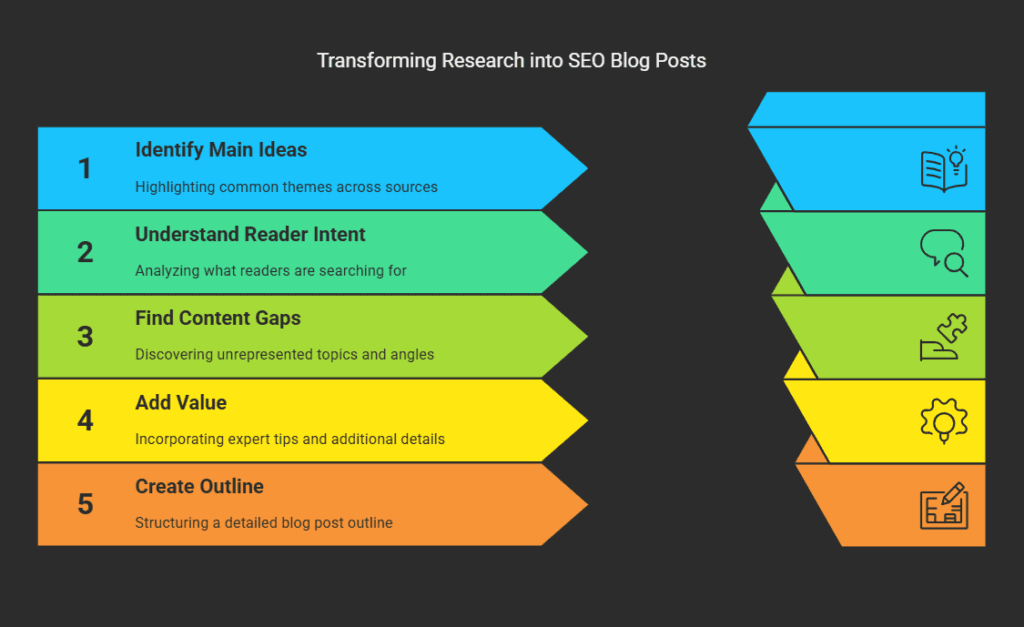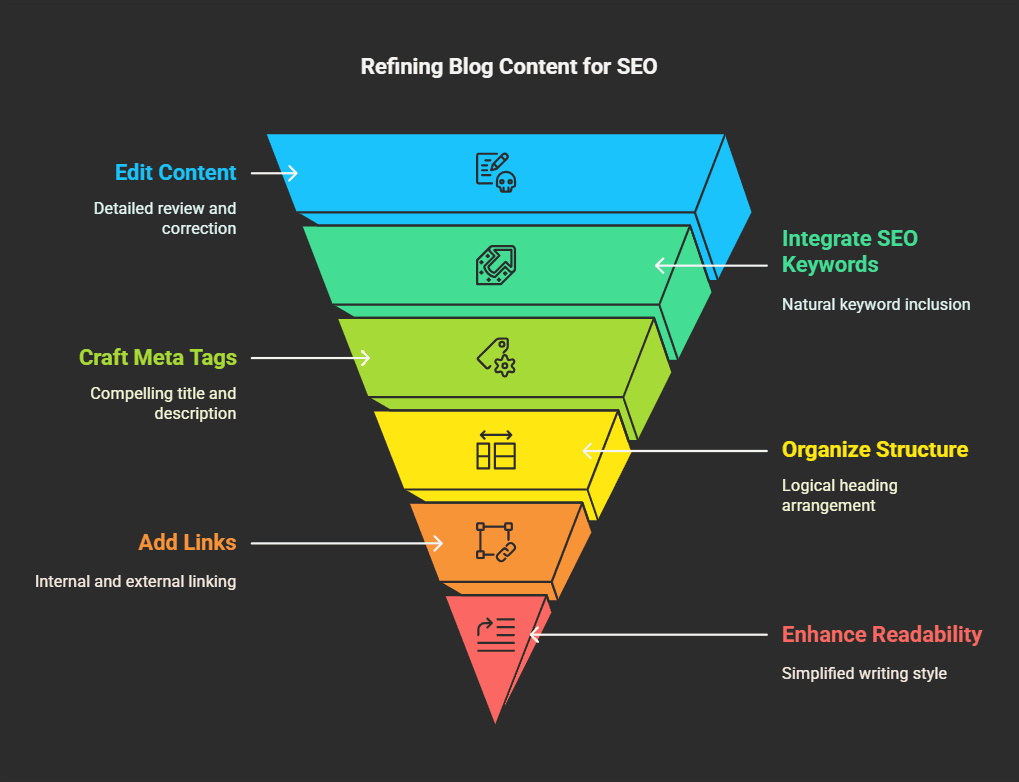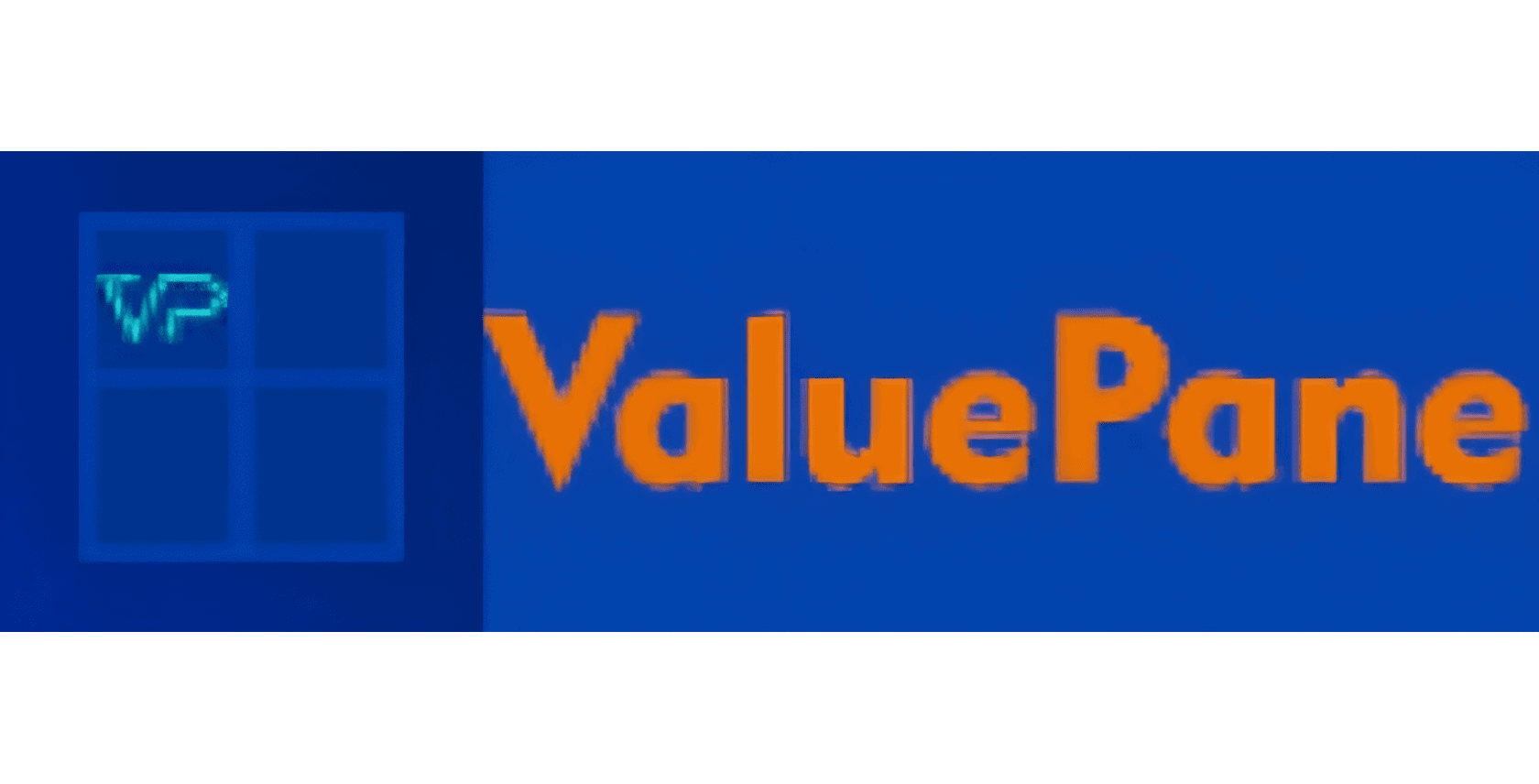Hello reader! In today’s digital age, creating blog posts that not only resonate with your audience but also rank high on search engines like Google is significantly important. So, in this post let us dive into the creative world of crafting high- ranking SEO blog posts using Google NotebookLM.
This amazing AI tool can simplify the whole process of content creation, saving you time and help you produce top-notch content.
Let me walk you through the process of leveraging Google NotebookLM to craft impactful, SEO-friendly blog posts in this comprehensive guide.
Table of Contents
Why Bother with SEO-Friendly Blog Posts?
You may wonder, “Why all this fuss about SEO?” Well, think of it this way: Say, you’ve created some incredible content, but how will people find it? That’s where Search Engine Optimization (SEO) comes in. When your blog posts are optimized for SEO, they have a better chance of appearing higher in Google’s search results. This means more people will see your content, visit your website, and ultimately, you’ll be reaching your target audience effectively. It’s like having a spotlight shining directly on your amazing work.

Meet Your New Content Creation Ally: Google NotebookLM
So, what exactly is Google NotebookLM? It’s a powerful AI tool designed to help you with various content-related tasks, and it really shines when it comes to creating blog posts with a focus on SEO. What makes it stand out are its features specifically designed for this purpose. We’re talking about a way to streamline your entire content production process, from research to publishing, all within a user-friendly environment.
Your Step-by-Step Guide to High-Ranking Blog Posts with NotebookLM
Ready to get started? Let’s walk through the content production process with Google NotebookLM step by step:
1. Laying the Foundation: Topic Selection and Research
First things first, you need to decide what you want to write about. Let’s say, for example, you are a travel enthusiast and you want to write about the “Top Places to Visit in India”. Once you have your topic, it’s time for a little research. Your goal here is to find out what’s already ranking well on Google for your chosen topic.
Open up Google and search for your topic, just like your potential readers would. Take a look at the articles that are appearing at the top. These are the ones that Google sees as valuable and relevant.
You should look for the top-ranking organic blog posts including YouTube videos. The ones that appear naturally in the search results, not under the tag “Sponsored”.

2. Gathering Your Resources: Adding Sources to Google NotebookLM
Once you’ve identified those top-ranking blog posts, the next step is to bring them into Google NotebookLM.
Here’s how:
Head over to Google NotebookLM and log in with your Google account.
Create a new notebook for your blog post.
Now, copy the URLs of those top-ranking articles you found and use the “Add Source” option in NotebookLM to include them. These will be the foundation upon which you’ll build your blog post content.
Some web page’s may not be readable after importing into NotebookLM. These sites may have blocked web crawlers or specific bots. Do not get upset, there’s a clever workaround.
You can use a Chrome extension like FireShot to save the entire webpage as a PDF. Then, in NotebookLM, instead of adding a URL, simply upload the PDF file as a source.
Or, you may copy the entire written content of the web page and paste it under the Copied text section in the Sources. Also remember to copy and paste the URL and Title of the page for future reference.
3. The Magic of Prompt Chaining: Guiding NotebookLM to Success
Now for the really exciting part: using NotebookLM to help you write your blog post through a series of guided steps called prompt chaining. Think of it as having a conversation with the AI, leading it step-by-step to create the content you envision.
Here’s a 5-step prompt chain you can adapt for your own topics:
Phase 1: Enhanced Analysis and Intent Identification
- Step 1: Deeper Thematic Analysis and Audience Understanding
- Prompt 1: “Analyze the provided top-ranking organic blog posts for [your chosen keyword]. Identify the most frequently mentioned themes, topics, and key points, and highlight any common elements. Furthermore, analyze the language and tone used in these posts. Based on this analysis, describe the likely target audience (their level of knowledge, interests, and needs) for this topic. What questions are these articles primarily trying to answer?”.
- Outcome: This helps you understand the common threads and essential information that are considered important for your topic. You’ll get a clear picture of what the leading articles are focusing on.
- Reasoning: This prompt not only identifies common themes but also pushes NotebookLM to understand the audience the top-ranking content is targeting. Understanding the audience from the beginning will help tailor the subsequent content for greater usefulness and uniqueness.
- Step 2: Explicitly Define Search Intent and Content Gaps
- Prompt 2: “Based on your analysis of the top-ranking blog posts and the identified target audience, clearly define the primary search intent behind the keyword ‘[your chosen keyword]’. Then, identify any important aspects, subtopics, or specific questions that are either unrepresented or not thoroughly addressed in these resources. List any potential content gaps that a new blog post could fill to provide more comprehensive value”.
- Outcome: This step is crucial for understanding what your audience is really looking for when they search for your topic. Are they looking for information, a how-to guide, reviews, or something else? Knowing the search intent will help you tailor your content to meet their needs.
- Reasoning: This prompt builds directly on the audience understanding from Prompt 1 and explicitly asks for content gaps. By focusing on what’s missing, we directly aim for more unique and useful content.
Phase 2: Strategic Content Planning and Outline Generation
- Step 3: Brainstorming Unique Angles and Value Propositions
- Prompt 3: “Considering the identified content gaps and the target audience’s needs, brainstorm at least three unique angles, fresh perspectives, or specific value propositions that a new blog post on ‘[your chosen keyword]’ could offer to readers. These angles could involve a specific niche within the topic, a particular methodology, a focus on a specific type of reader, or the incorporation of personal experiences (as you suggested in our previous conversation). Briefly describe each unique angle”.
- Outcome: This is where you find opportunities to make your blog post stand out. Are there any important aspects that the top-ranking articles haven’t covered? Can you offer a fresh perspective or add unique value? This is your chance to be original.
- Reasoning: This prompt is designed to inject uniqueness into the content planning phase. By explicitly asking for unique angles before outlining, we guide NotebookLM to think beyond simply summarizing existing information.
- Step 4: Detailed Outline Creation with Unique Elements
- Prompt: “Based on the common themes, defined search intent, identified content gaps, and the unique angles you brainstormed, please create a detailed outline for a blog post on ‘[your chosen keyword]’. Include suggested headings, subheadings, and key points for each section. Ensure the outline incorporates at least one of the unique angles identified in the previous step. Consider how multimedia elements like images, potential podcasts, or illustrations (as mentioned in the sources) could be integrated to enhance the content’s value and uniqueness.”.
- Outcome: This step helps you enrich your blog post with depth and detail. Even though NotebookLM doesn’t have real-time internet access, it can draw upon its vast training data to provide relevant insights.
- Reasoning: This prompt now directs the outline creation process to incorporate the unique elements that were brainstormed. It also reminds the AI to consider diverse content formats from the beginning, contributing to a more engaging and unique final product.
4. Bringing Your Vision to Life: Completing the Blog Draft
With your detailed outline in hand, it’s time to ask NotebookLM to generate the content.
Phase 3: Content Generation and Refinement with Plagiarism Prevention and Value Focus
- Step 5: Comprehensive Blog Post Generation with Tone and Uniqueness Emphasis
- Prompt: “Using the detailed blog outline created previously, please write a complete blog post in markdown format on ‘[your chosen keyword]’. Choose a [specify a tone, e.g., conversational, expert, friendly] tone of voice for the content and maintain it consistently. Actively incorporate the unique angle chosen in the outline. When generating the content, ensure that it provides clear, helpful, and accurate information that directly addresses the search intent and fills the identified content gaps. Focus on creating original content that synthesizes information from the sources in a new way, rather than directly copying phrases or sentences. Aim to provide significant value to the reader, making it a useful resource.”.
- Outcome: Finally! You have laid the groundwork for a well-structured and comprehensive blog post. This outline will be your roadmap for writing the full content.
- Reasoning: This prompt emphasizes originality and value creation during the writing process. By explicitly instructing the AI to synthesize information and avoid direct copying, we aim to minimize plagiarism. Incorporating the unique angle at this stage ensures it is woven throughout the content.

5. Polishing Your First Draft: Editing and Enhancing Your Blogpost
Once NotebookLM has generated the draft, it’s your turn to refine it.
Review the draft in a tool like Google Docs for detailed edits. Check for clarity, accuracy, and flow.
Add visual elements such as images and videos to make your content more engaging. Remember, a visually appealing blog post can capture and retain your readers’ attention much better.
Post-Generation Steps for Plagiarism Check and Enhancement:
While these improved prompts aim to minimize plagiarism, it’s crucial to implement the following steps after the initial draft:
- Plagiarism Check: Utilize a plagiarism detection tool to thoroughly check the generated blog post against the source materials and the wider web. Identify any potential instances of unintentional plagiarism and rewrite those sections in your own words.
- Human Review and Personalization: Always try to add your own experiences, insights, and unique perspective to the blog post. This is the most effective way to ensure uniqueness and enhance the content’s value and authenticity.
- Backlinking and Multimedia Integration: Follow the practical advice from the source to strategically add backlinks to valuable external resources and integrate multimedia elements like images, embedded podcasts (if applicable), and illustrations to make the content more engaging and unique.
- Value and Usefulness Assessment: Review the completed blog post from the perspective of the target audience. Does it clearly answer their questions? Is the information accurate and helpful? Does it offer a unique perspective or valuable insights beyond what’s already available in the top-ranking results? Make any necessary revisions to improve its overall usefulness.
6. Expanding Your Reach: Repurpose into a Podcast
Here’s a fantastic way to cater to a wider audience: convert your blog post into a podcast. Tools within NotebookLM can even help with narration. Once you have your audio version, you can upload it to platforms like SoundCloud and even embed it directly into your blog post. This gives your readers another way to consume your content, whether they prefer reading or listening.
To create a podcast from your blog post, you can save your written content as a note in NotebookLM. Then, you can use the audio preview feature and customize it by providing background information, specifying what to focus on, and defining your target audience. You can then download the generated audio file and upload it to a podcast hosting platform like SoundCloud. You’ll get an embed code that you can then paste into your blog post.
7. Sharing Your Masterpiece: Publishing Your Blog
The final step is to share your hard work with the world!
Publish your blog post on your website.
Consider catering to diverse preferences by offering both written and audio formats if you’ve created a podcast version.
Taking Your SEO to the Next Level
Creating a great blog post is just the beginning. To truly unlock SEO success, consider these additional enhancements:
Strategic Backlinking: Just like the top-ranking articles you analyzed, linking to relevant and authoritative external sources can significantly enhance your blog post’s value and credibility. If you mention a specific concept or place, linking to a comprehensive resource about it can provide more value to your readers. Your primary goal should always be to provide value to the reader.
Engaging Visuals and Illustrations: Don’t underestimate the power of visuals. Relevant images and illustrations can break up large blocks of text, make your content more appealing, and help get your point across more effectively. You can use AI image generators like ChatGPT or tools like Napkin AI to create visuals.
Adding Your Unique Voice and Experience: While AI tools are incredibly helpful, remember that your own insights and experiences can add a special touch to your content. Don’t hesitate to weave in your personal perspective to make your blog post truly unique.
Readability Matters: Make sure your blog post is easy to read and understand for a broad audience. Writing at a sixth-grade reading level is often recommended for maximum clarity and accessibility. Use shorter sentences and paragraphs to improve readability [Me].
Advanced NotebookLM Strategies for SEO
Beyond the basic blog post creation, NotebookLM can assist with more advanced SEO tasks:
Competitive Analysis for Outlines: You can use NotebookLM to analyze the top-ranking competitors for a specific keyword and generate SEO-optimized content outlines based on their content structure, identified LSI keywords, and search intent. By feeding the URLs of your competitors’ pages into NotebookLM and using specific prompts, you can gain valuable insights into what’s working well in your niche.
Repurposing YouTube Content: If you have video content, you can transcribe it and use NotebookLM to repurpose it into SEO-friendly blog posts. Simply add the video transcript as a source and prompt NotebookLM to create a blog post based on the content, optimizing it for relevant keywords. This allows you to reach a wider audience across different content formats.
Improving Existing Content: You can also use NotebookLM to analyze your existing blog posts and get suggestions for SEO improvements. By adding your own blog post as a source, you can ask NotebookLM for feedback on keyword optimization, meta tags, content structure, links, search intent, and readability. This can help you identify areas for improvement and boost the ranking of your existing content.
Real-Life Scenario
What is better than a live example! The post that you are reading right now has been generated using NotebookLM following the exact steps and using the prompts that I have detailed above.
Video Resource
Here is a video resource from Nico of AI Ranking detailing the prompt chaining process to use NotebookLM
Download Resource
You can download the Prompt Chain to Craft High-Ranking SEO Blog Posts using NotebookLM
Conclusion
Google NotebookLM is a game-changer for content creators looking to craft high-ranking blog posts efficiently. By leveraging its AI capabilities for research, outlining, and drafting, you can save valuable time while producing quality, SEO-friendly content.
Remember that while AI is a powerful tool, your creativity, strategic thinking, and personal touch are essential for creating truly impactful and unique blog posts.
By implementing the prompt chaining technique and following the post-generation steps, you can leverage Google NotebookLM more effectively to create a better draft outline and a fully detailed blog post that has a higher likelihood of being original, serving the search intent, and providing valuable content to your target audience.
So, don’t hesitate to experiment, keep learning, and unlock your SEO success with Google NotebookLM!
Share your views and improvisations in the comments below.
